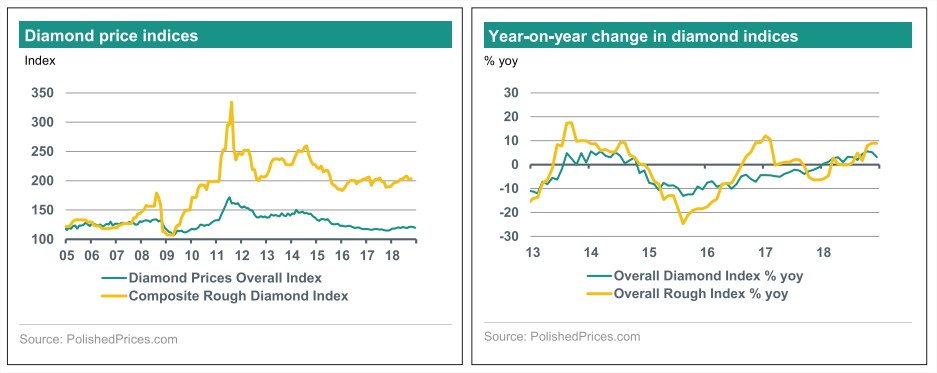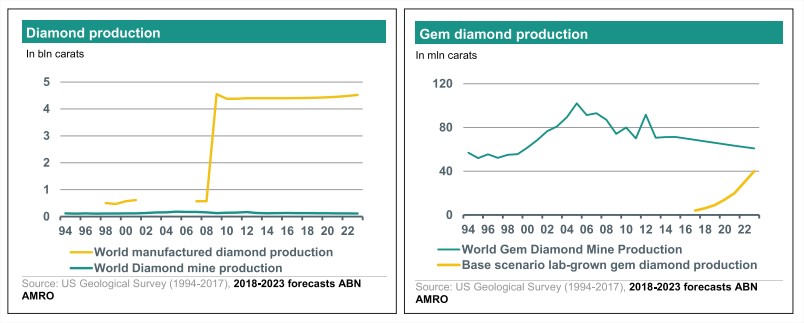The diamond industry has moved from a relatively stable environment to a highly uncertain environment, according to an ABN Amro report. Edited excerpts below:
In a diamond sector outlook report dated January 15th, 2019, ABN Amro senior precious metals & diamonds analyst, Georgette Boele, notes that following the launch of De Beers’ lab-grown diamond jewellery brand last year, “2019 and the years ahead will see lab-grown diamonds for jewellery entering the growth phase”.
This has serious consequences for the actors in the diamond industry. Natural diamond buyers such as retailers, consumers and jewellery manufacturers will likely de-stock and hold less inventory. This will result in lower demand for natural diamonds and weigh on prices. Miners will rethink their strategy in light of uncertainty about natural diamond demand, and questions about the value of a diamond. Lab-grown diamond producers will probably focus on technology to become less energy dependent, or use more sustainable energy sources, to increase the product suite and lower prices for the lab-grown diamonds used in jewellery. Consumers will profit from the wider variety of diamonds at more attractive prices.
On May 29th, 2018, De Beers launched a laboratory-grown diamond jewellery brand, Lightbox Jewellery. This was a shock to the industry. Gem-quality lab-grown diamonds threaten the business case of miners, now even more so than before. This has created a lot of uncertainty in the diamond industry. If 2018 was the year that lab-grown jewellery diamonds were officially introduced as an acceptable new product, what will 2019 bring?
Growth phase for lab-grown diamonds
We think that 2019 and 2020 will be the years that lab-grown diamonds take off and move from an introduction phase (2018) to a growth phase. Lab-grown diamond producers have been able to produce larger and better-quality lab-grown diamonds. Moreover, more companies and persons in the diamond industry are willing to jump on the lab-grown diamond experience.
For example, New Diamond Technology LLC – a Russian company – has announced that it has produced a 103.50-carat labgrown diamond. This is the largest ever lab-grown diamond.
Moreover, Lightbox of De Beers plans to sell its lab-grown diamond jewellery not only via its own website, but through retail partnerships for online and in-store sales.
In future there will most likely be a wider variety of colours. Lightbox and some other labgrown diamond (jewellery) providers have decided to leave wedding jewellery or engagement rings out of the offering (for now). We think sooner rather than later lab-grown diamond wedding jewellery will be part of the offering.
We think that because of technology and the attractive margins in this segment, it is just a matter of time before the larger stones will also face serious competition from lab-grown diamonds. As a result, it is likely or even recommended that the inventory of natural diamonds decreases, as there is great uncertainty about the future value of natural diamonds. So traders and other buyers will probably hold lower inventories and be less aggressive in buying new diamonds. In addition, jewellery houses will decide whether they will offer lab-grown diamond jewellery pieces or not. If they were to offer lab-grown diamond jewellery as well, they would probably adjust the offering of natural diamond jewellery accordingly. As a result, it is likely that demand for natural diamonds will decline.
Changing strategies
Manufacturers will polish both natural and lab-grown diamonds. The polishing of lab-grown diamonds could be somewhat different as the growth-structure differs (flat, cubic or octahedral growth structures). Most natural diamonds have an octahedral or dodecahedral growth structure. An octahedral natural diamond will be cut in two, resulting in a larger round brilliant diamond and a smaller brilliant diamond. If the growth form is cubic there are other possibilities to cut and polish diamonds. In short, the skill-set of the polisher will be enhanced in this new phase of growth.
The natural diamond miners will have some possible strategies to brace for the growth of labgrown diamonds. First, they could speed up mining activity to cash in on their diamond reserves. In a few years from now it is highly uncertain if natural diamonds will hold their value as always has been assumed. Some producers and/ or countries have indicated that they will step up production in the future.
De Beers has announced that it expects output for 2018 to reach 35 to 36 million carats. This is the highest output since 2008. In 2019 there will probably be a fall in output because of some production challenges but the output for 2020 and 2021 is expected to surpass the level of 2018. Moreover, Angola has signalled that it will double production. It is unclear if the step-up in production has anything to do with the developments in lab-grown diamonds. However, Alrosa has indicated that it will hold back supply in 2019 to avoid flooding the market.
Second, the miners could stop searching for new mines as the high exploration costs will unlikely be paid back by future income from natural diamonds.
But if consumers were to increasingly opt for the lab-grown diamond jewellery this would negatively impact demand for natural diamonds. Consumers will probably get a larger and better quality stones for their money. As a result, it is likely that natural diamonds will decline in value because of lower demand.
Third, miners could launch labgrown diamonds or team up with a lab-grown diamond producer. We think this will increase the future survival changes of a natural diamond miner.
The lab-grown diamond producers have also a few strategies to survive in this highly uncertain environment: securing cheaper and more sustainable sources of energy; focusing on technology could result in lower energy and production costs as well as a wider product range; improving distribution by building a sophisticated website and/or partner up with jewellery brands and stores; and offering lab-grown diamonds for wedding jewellery at more attractive prices.

Diamond prices will decline
We expect lower rough and polished prices for various reasons. First, natural diamond buyers will scale back their natural diamond purchases because they will probably like to bring down their current inventory and keep it smaller. With the uncertainty about consumer natural diamond demand and uncertainty over how stable the value of natural diamonds is, buyers are likely to be more cautious.
Second, it is likely that some of the natural diamond buyers including retail houses will want to offer a wider range of diamonds, including natural and lab-grown diamonds. This will eat into the budget of buying natural diamonds.
Third, the power of the miners is decreasing because of higher uncertainty. An oligopolistic market structure as seen in the diamond industry is not suitable for an uncertain environment. The industry will probably change from an oligopolistic structure to a structure with more competitors and stronger competition.
Fourth, if consumers are more attracted to lab-grown diamonds for jewellery, this will also result in lower demand for certain groups of natural diamonds. If lab-grown diamonds are able to compete with the higher quality and larger stones of natural diamonds, this will likely also add pressure on polished and rough natural diamond prices. It is likely that the wider acceptance of lab-grown diamonds will result in rough and polished diamond prices moving more in sync because the power of the supplies/miners is moving towards the buyers and competition is increasing.
Last but not least, we also expect lower prices for lab-grown diamonds. Higher lab-grown diamond production and better technology will drive lab-grown prices lower.
Consumers stand to gain
We are of the view that the consumers are the clear winners. Consumers will be able to buy a diamond at more attractive prices. But they also have to realise that lab-grown diamonds do not hold investment value. In addition, lab-grown diamonds will give consumers larger, better quality stones for more affordable prices. Moreover, a range of colours will be more accessible for consumers.

